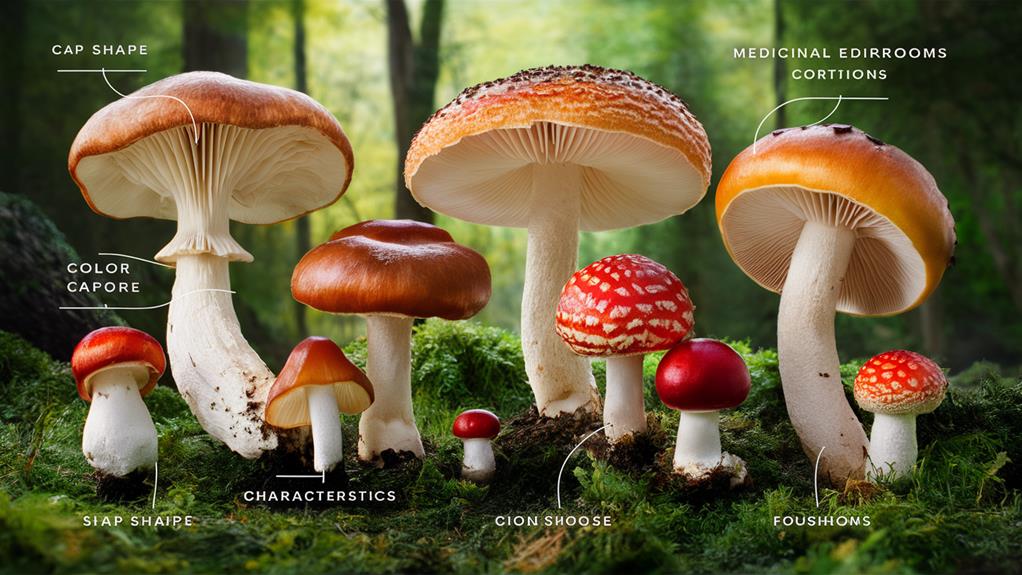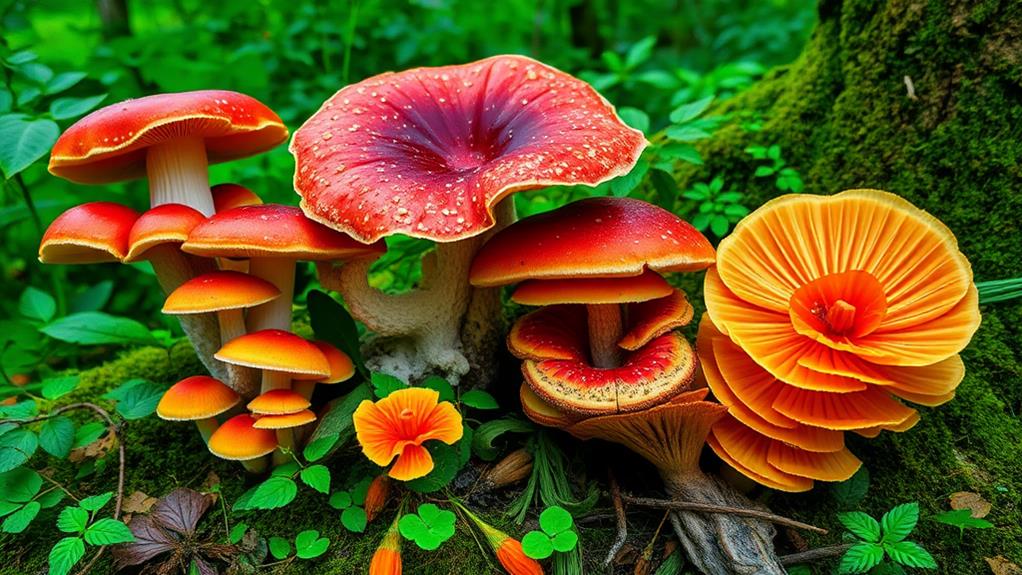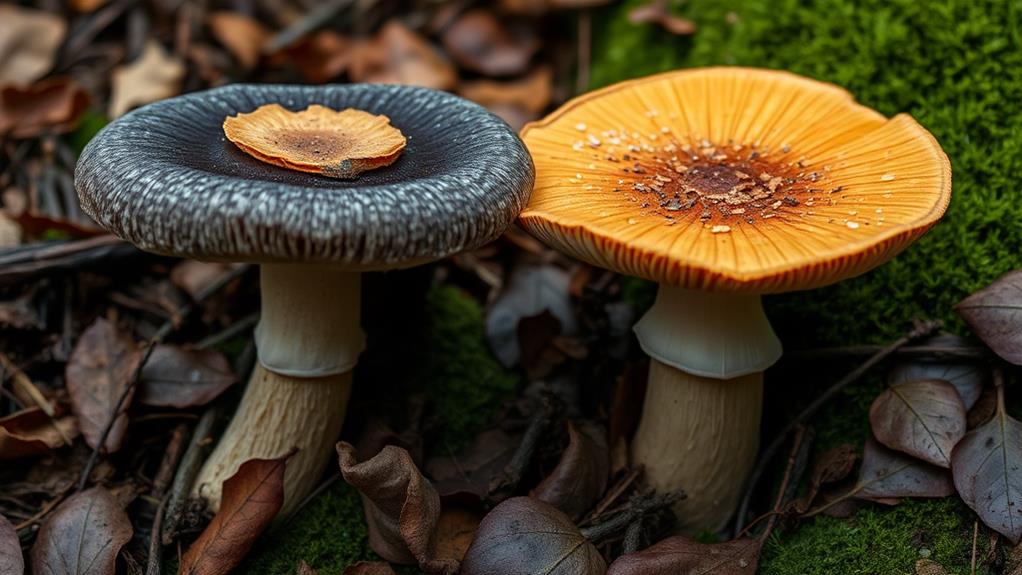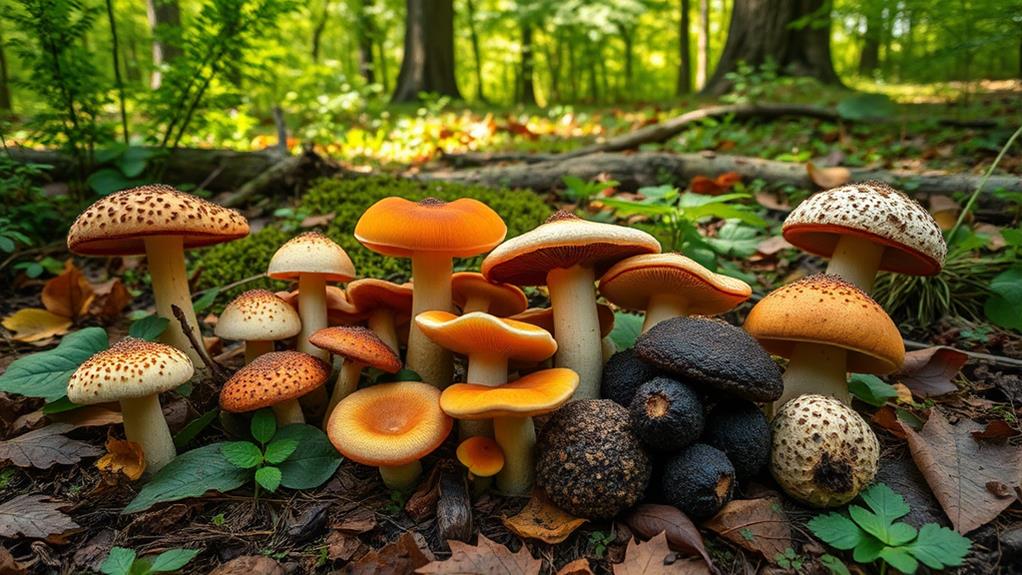
To identify medicinal edible mushrooms, start by observing their color and shape. Look for bright colors and unique shapes, like the pom-pom of Lion's Mane. Check the gills: brown or tan usually indicates edibility, while white might signal toxicity. Pay attention to their habitat; for example, Reishi grows on decaying hardwood. Always forage in familiar areas and avoid contaminated regions. Be cautious of look-alikes, like the false morel. Finally, cooking mushrooms can enhance their benefits. As you explore these techniques, you'll discover even more about the fascinating world of medicinal mushrooms.
Understanding Medicinal Mushroom Benefits

Medicinal mushrooms are nature's powerhouses, offering a range of health benefits that can enhance your well-being. These edible fungi, like Reishi and Lion's Mane, are known for their adaptogenic properties, helping your body cope with stress while promoting overall wellness.
When you incorporate these mushrooms into your diet, you might find improvements in your immune function, which is crucial for fighting off illnesses. Some medicinal mushrooms, such as Turkey Tail, have been shown to enhance immune function and potentially improve survival rates in cancer patients. Certain types, such as Turkey Tail, contain polysaccharopeptides that have been studied for their potential to boost your immune response and support cancer treatment.
Lion's Mane mushrooms are particularly interesting, as research suggests they may enhance cognitive health, stimulating memory and nerve growth factor (NGF) production.
If you're looking for an energy boost, Cordyceps mushrooms may help, as they've been linked to increased athletic performance and improved oxygen utilization.
Many medicinal mushrooms also possess powerful antioxidant properties, which contribute to their ability to combat chronic diseases and support immune health.
Key Identification Features
When you're identifying medicinal edible mushrooms, paying attention to color and shape is crucial.
You'll also want to observe the gills or pores, as these can help distinguish similar species.
Additionally, knowing the habitat and seasonality of these mushrooms can guide you in your search, ensuring you find them in the right locations at the right times.
Color and Shape
Identifying edible mushrooms involves paying close attention to their color and shape, which serve as key features in distinguishing species. The vibrant colors of medicinal mushrooms can be telltale signs. For instance, the bright orange of Chanterelles or the dark brown to black of Reishi can help you identify them easily.
Additionally, mushrooms are high in protein and vitamins, making them a nutritious addition to your diet. The shape of mushrooms is equally important; take Lion's Mane, which has a unique pom-pom appearance with cascading spines, or Shiitake, with its broad, umbrella-like cap.
Mushroom caps can vary significantly in size—the medium-sized, rounded cap of Porcini contrasts with the large, meaty Portobello. As you observe, remember that color changes upon bruising can also indicate edibility. Some edible species may show vibrant colors when damaged, while others won't change at all. This emphasizes the importance of careful observation when identifying these fungi.
While you'll learn more about gills and pores later, focusing on color and shape is crucial for your early identification efforts. By honing in on these aspects, you'll build a strong foundation for recognizing medicinal edible mushrooms in their natural habitat.
Gills and Pores
After getting familiar with color and shape, the next step in identifying mushrooms is examining their gills and pores. Gills can vary significantly; some are free, meaning they don't attach to the stem, while others are attached. This distinction is crucial for identifying different types of mushrooms, especially when determining if they're edible or poisonous.
For example, many edible mushrooms have brown or tan gills, while white gills often indicate toxic mushrooms, such as those in the Amanita family.
You should also pay attention to pore structure. Mushrooms like boletes have a sponge-like surface instead of traditional gills, making them safer choices for mushroom foraging. Observe the spacing and thickness of the gills or pores too; densely packed gills might suggest certain varieties, while wide-spaced gills can point to others.
Additionally, check for features like a ring or skirt on the stem. Many edible varieties lack this feature, which can aid in identifying different mushrooms.
Habitat and Seasonality
Understanding the habitat and seasonality of medicinal edible mushrooms is essential for successful foraging. These mushrooms, like Reishi and Lion's Mane, thrive in specific environments. You'll typically find Reishi growing on decaying hardwood trees, while Lion's Mane prefers dying or dead trees in temperate forests. Notably, these species are rich in bioactive compounds, which contribute to their health benefits and make them sought after in both culinary and medicinal contexts top medicinal mushrooms.
Seasonality also plays a crucial role in their growth. For instance, Chanterelles often appear from late summer to early fall, whereas Turkey Tail can be spotted year-round.
Keep in mind that environmental factors, such as moisture levels and temperature, significantly influence fruiting. Most medicinal mushrooms thrive in damp conditions and moderate temperatures.
When foraging, it's vital to recognize the unique habitat preferences of each type. For example, Cordyceps are found in grasslands or forested areas where their host insects reside.
Additionally, some medicinal mushrooms are region-specific, flourishing in particular soil types and climatic conditions.
To maximize your foraging success, familiarize yourself with the local ecosystems. This knowledge will help you identify where to look for these valuable mushrooms and when to find them, making your foraging adventures rewarding and fruitful.
Popular Medicinal Mushroom Varieties

When it comes to popular medicinal mushrooms, you'll find a variety of fascinating options that offer both healing properties and culinary uses.
For instance, Reishi is often used for its immune-boosting benefits, while Lion's Mane may help with brain function and nerve health.
Exploring these mushrooms not only opens up new flavors in your cooking but also introduces you to their potential health benefits.
Healing Properties Overview
Medicinal mushrooms offer a variety of healing properties that can support overall health and well-being. When you learn to identify edible mushrooms, you'll discover that many of them pack potent benefits.
For instance, Reishi mushrooms are famous for their immune-boosting properties, helping to reduce stress and promote longevity. If you're interested in cognitive health, Lion's Mane could be a great choice. It may enhance memory and focus while stimulating nerve growth.
Chaga mushrooms stand out due to their rich antioxidant content and potential anti-inflammatory properties. They're being studied for their ability to support immune function and even combat cancer.
Cordyceps, another remarkable variety, is known for increasing energy and athletic performance by improving oxygen utilization and blood flow, making it popular among athletes.
Culinary Applications Explained
Exploring the culinary applications of popular medicinal mushrooms can enhance your meals while providing health benefits.
These mushrooms not only taste great but also offer unique properties that can improve your overall well-being. Here are some delicious ways to incorporate them into your cooking:
- Reishi mushrooms: Brew them into tea or add powdered reishi to soups and smoothies for immune support.
- Lion's Mane mushrooms: Their unique texture makes them perfect for stir-fries and soups, boosting cognitive health.
- Cordyceps: Toss them into stir-fries or take as a supplement for energy and athletic performance.
- Chaga mushrooms: Use them in tea or mix with coffee and smoothies for a powerful antioxidant boost.
- Turkey Tail mushrooms: Add powdered turkey tail to soups or broths to support gut health and immune function.
When you're learning to identify mushrooms, be cautious of poisonous look-alikes, especially with mushrooms growing in the wild.
Always ensure you're using edible varieties, such as the edible puffball, to enjoy their culinary applications safely and effectively.
Enjoy your cooking adventures while reaping the health benefits these mushrooms offer!
Safety Tips for Foraging
Foraging for mushrooms can be both exciting and rewarding, but safety should always come first. Always go foraging with a knowledgeable guide or expert. This is crucial to avoid misidentifying medicinal mushrooms, as many have toxic look-alikes that can lead to serious health risks.
It's also important to use a reliable field guide specific to your region. Pay attention to key characteristics like color, shape, and habitat to help you identify mushrooms correctly.
You should avoid consuming mushrooms found in contaminated areas, such as near roadsides or industrial sites. These locations can expose mushrooms to environmental toxins that may harm your health.
Keep a sample of any new mushroom in your fridge for identification verification. Consult multiple sources before eating any wild foraged mushroom to ensure it's safe.
Recognizing Look-Alikes

Recognizing look-alikes is essential when you're foraging for edible mushrooms, as many species can easily be confused with toxic varieties. Knowing the differences between similar mushrooms can help identify those that are good edible options and avoid poisonous fungi.
Here are some critical comparisons to consider:
- Reishi (Ganoderma lucidum): Shiny red cap and white pores versus other dull-colored caps.
- True Morels (Morchella spp.): Honeycomb appearance compared to the lobed, irregular caps of False Morels (Gyromitra spp.).
- Chanterelles (Cantharellus spp.): Forked gills and yellow to golden hue versus Jack-o'-lantern mushrooms (Omphalotus illudens) with true gills and more orange color.
- Lion's Mane (Hericium erinaceus): Long, cascading spines versus short, tooth-like spines of the Hedgehog mushroom (Hydnum repandum).
- Turkey Tail (Trametes versicolor): Vibrant concentric circles of color against the thicker, flatter caps of harmful species.
Cooking and Culinary Uses
Cooking with medicinal edible mushrooms opens up a world of flavors and health benefits that can enhance your meals in delightful ways.
These mushrooms, like Reishi and Lion's Mane, can be added to soups, teas, or smoothies, providing unique tastes and boosting your health. When you cook mushrooms, it helps release their beneficial compounds, making them more bioavailable and easier to digest. This is especially important for varieties like Chaga and Turkey Tail.
To maximize their nutrients, simmer medicinal mushrooms in water to create a rich broth. This method extracts their health benefits, making it perfect for various culinary dishes.
You can also sauté mushrooms like Cordyceps and Shiitake with garlic and herbs, which enhances their taste and nutritional profile, making them a fantastic addition to stir-fries and pasta.
If you want a quick way to incorporate mushrooms into your diet, consider using dried medicinal mushrooms in powdered form. This allows you to add them easily to recipes, like smoothies or baked goods, without changing the dish's original flavor.
Enjoy the many ways you can cook with these amazing ingredients!
Seasonal Availability of Mushrooms

Throughout the year, the availability of medicinal edible mushrooms varies, influenced by seasonal changes and regional climate conditions. Knowing when to look for these mushrooms can enhance your foraging success.
Here's a quick guide to help you identify the seasonal availability of some popular varieties:
- Morels: Available in spring, typically from April to June.
- Shiitake: Can be harvested year-round if cultivated, but wild ones fruit in late summer to early fall.
- Chanterelles: Thrive from late summer to early autumn, especially under hardwood trees in moist areas.
- Maitake: Found in late summer to early fall, with peak seasons depending on your geographical location.
- Reishi, Lion's Mane, and Chaga: These medicinal mushrooms generally fruit in late summer to early fall.
Understanding the seasonal availability of these edible mushrooms can make foraging easier and more rewarding.
Pay attention to local climate conditions, as they can significantly impact when you'll find these treasures.
By knowing the best times to search, you can enjoy the benefits of medicinal mushrooms while connecting with nature.
Happy foraging!
Resources for Further Learning
For anyone eager to deepen their knowledge of medicinal edible mushrooms, there are numerous resources available to enhance your learning experience.
First, consider joining local mycology clubs or online forums. These communities let you engage with experienced foragers who can share valuable insights on identifying medicinal edible mushrooms.
You might also want to attend workshops or classes led by mycologists. These sessions often focus on hands-on identification techniques, helping you understand the medicinal properties of various fungi.
Additionally, using reputable field guides like "Mushrooms Demystified" or "Medicinal Mushrooms: The Essential Guide" can provide you with comprehensive information and identification tips.
Don't forget to explore online databases and websites dedicated to medicinal mushrooms, such as the Medicinal Mushroom Resource Center. These platforms offer in-depth knowledge and research findings that can further your understanding.
Finally, participating in guided foraging events is a fantastic way to practice your identification skills in the field while learning about the specific habitats where medicinal mushrooms thrive.
Conclusion
In your journey to identify medicinal edible mushrooms, remember that knowledge is your best tool. Just as some mushrooms can heal, others can harm, so it's crucial to stay informed and cautious. Use the key identification features and safety tips we discussed to guide you. Whether you're foraging in the wild or cooking in your kitchen, embracing these fungi can enhance your meals and health. So, dive in, learn, and enjoy the wonders of nature's bounty!
